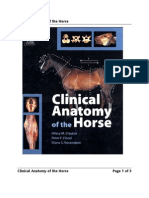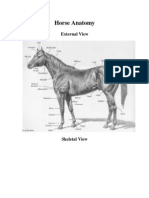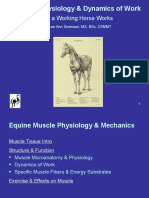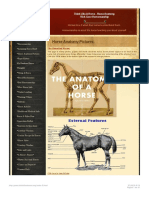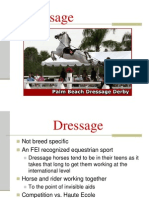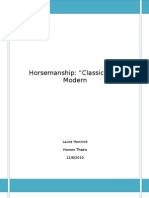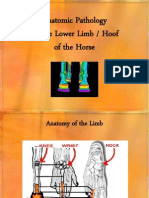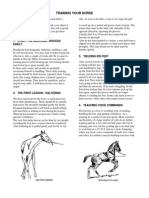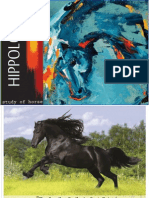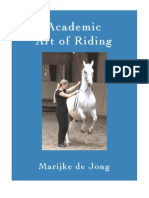The Equine Skeletal System
The Equine Skeletal System
Uploaded by
Savannah Simone PetrachenkoCopyright:
Available Formats
The Equine Skeletal System
The Equine Skeletal System
Uploaded by
Savannah Simone PetrachenkoCopyright
Available Formats
Share this document
Did you find this document useful?
Is this content inappropriate?
Copyright:
Available Formats
The Equine Skeletal System
The Equine Skeletal System
Uploaded by
Savannah Simone PetrachenkoCopyright:
Available Formats
The Skeletal System
Functions Protection of vital organs Locomotion Dynamic storage for minerals Bones are living Classication of Bones Long Short Flat Sesamoid Pneumatic Only the sinuses are pneumatic bones (have air in them) Irregular
Axial = head, neck, ribcage, and back Appendicular = legs The Equine Skull
Mandible = bottom Maxilla = top Function of the facial crest Foramen = hole Axial Skeleton: Vertebral Column
Thorax = chest 18 ribs Thoracic = does not move
Lumbar = more exibility Lumbosacral junction = junction between the hindquarters and the rest of the horse
Cervical Spine Injuries The spinal nerves that supply the limbs have to pass through the spinal canal. Any inammation in or around the spinal cord can directly effect the gait in all 4 limbs. When these nerves are damaged, the horse can become ataxic. Ataxia: Horse cannot control its limbs (NOT safe to ride, requires neurological exam) 1 = just noticeable 5 = horse is down Wobblers: Cervical vertebral malformation Horse is ataxic Narrowing of the cervical spinal canal Instability of the cervical spinal canal Example: Young, fast-growing horse Excessive caloric intake Imbalance of trace minerals Compromised bone development OCD (osteocondrosis) Add intense training (Rolkr) Trauma to vertebrae Degeneration Compression of the spinal cord
Axial Skeleton
Appendicular Skeleton
Pelvic Anatomy Pelvis Ilium Ischium Pubis Hip Joint Ball and socket The Hindlimb
Landmarks Triangle of hindquarter Wing of ilium Point of buttock Stie Lumbosacral (LS) placement Strength of LS (loin) Functional Conformation Stie location Length of femur Length of tibia Placement of hock The Forelimb
Landmarks Point of shoulder Slope of shoulder = scapula Length of humerus Point of elbow Slope of pastern Anatomy of the Shoulder Joint No true bony connection "synsarcosis" Functional Conformation Pillar of support Lightness of the forehand Strong coupling Strength of LS Matching stride lengths
You might also like
- Horse Brain Human Brain-ExcerptDocument20 pagesHorse Brain Human Brain-ExcerptSruti Robee S100% (1)
- The Illustrated Horse S Foot PDFDocument273 pagesThe Illustrated Horse S Foot PDFGIANELLA ESPINOZA MENDOZA86% (7)
- Equine Exercise PhysiologyDocument456 pagesEquine Exercise PhysiologyWilson Faria100% (1)
- Clinical Anatomy of The HorseDocument410 pagesClinical Anatomy of The HorseTom Roberts100% (5)
- FEI Horsemanship Competence PDFDocument76 pagesFEI Horsemanship Competence PDFShone Shone100% (1)
- 01 Body Conformation of HorseDocument32 pages01 Body Conformation of HorseDrSagar Mahesh Sonwane100% (4)
- Corrective Shoeing of Equine DenoixDocument9 pagesCorrective Shoeing of Equine DenoixEduardo JaraNo ratings yet
- Equine Radiographic AnatomyDocument32 pagesEquine Radiographic AnatomySam Bot100% (2)
- Article About Horse CommunicationDocument87 pagesArticle About Horse CommunicationMuhammad HaritsNo ratings yet
- The Equine Cardiovascular SystemDocument7 pagesThe Equine Cardiovascular SystemSavannah Simone PetrachenkoNo ratings yet
- Color Atlas of The Horses Foot CompleteDocument210 pagesColor Atlas of The Horses Foot CompleteMax MaxNo ratings yet
- Horse AnatomyDocument6 pagesHorse Anatomythe aass50% (2)
- Muscle Physiology & Dynamics of Work: How A Working Horse WorksDocument51 pagesMuscle Physiology & Dynamics of Work: How A Working Horse Worksleeann_swenson75% (4)
- Horse Anatomy Pictures-Think Like A Horse-Rick Gore Horsemanship ®Document41 pagesHorse Anatomy Pictures-Think Like A Horse-Rick Gore Horsemanship ®Laura B.100% (2)
- 1578 The Stay ApparatusDocument2 pages1578 The Stay ApparatusSamuel100% (2)
- Orse Onformation Nalysis: Cooperative ExtensionDocument12 pagesOrse Onformation Nalysis: Cooperative ExtensionJonathan Li100% (1)
- DressageDocument40 pagesDressageAngela DudleyNo ratings yet
- Equine BiomechanicsDocument19 pagesEquine BiomechanicsMiguel Villarroel Olano100% (1)
- Horse in MotionDocument318 pagesHorse in MotionSikaris480% (5)
- The Equine FootDocument4 pagesThe Equine FootSavannah Simone PetrachenkoNo ratings yet
- 4-H Colt and Horse Training ManualDocument20 pages4-H Colt and Horse Training ManualHelicon1No ratings yet
- TNH6000Document7 pagesTNH6000Jonathan LiNo ratings yet
- OttbcareDocument5 pagesOttbcareapi-431928511No ratings yet
- HorsemanshipThesisFinal 10Document55 pagesHorsemanshipThesisFinal 10Laura HanninkNo ratings yet
- Equine Canker (Pathologic Anatomy)Document138 pagesEquine Canker (Pathologic Anatomy)hil4ya100% (2)
- Examining and Judging a Horse - With Information on Breaking and Training HorsesFrom EverandExamining and Judging a Horse - With Information on Breaking and Training HorsesNo ratings yet
- EC Best Practices Buying SellingDocument32 pagesEC Best Practices Buying SellingAnonymous 1ToVe0hNo ratings yet
- Horse Evaluation HandbookDocument34 pagesHorse Evaluation Handbookapi-526186145No ratings yet
- Training Your Horse: 1. Start The Gentling Process EarlyDocument5 pagesTraining Your Horse: 1. Start The Gentling Process EarlyimmortalskyNo ratings yet
- Equine Body Condition ScoringDocument7 pagesEquine Body Condition ScoringAlbert Villasevil Florensa100% (1)
- Tips To Diagnose & Address Common Horse AilmentsDocument6 pagesTips To Diagnose & Address Common Horse AilmentsMark GebhardNo ratings yet
- CAVALLO Barefoot Trim ManualDocument14 pagesCAVALLO Barefoot Trim ManualHelicon1100% (1)
- Horse Locomotion - A Historical Article on the Mechanics of Equine MovementFrom EverandHorse Locomotion - A Historical Article on the Mechanics of Equine MovementNo ratings yet
- Hoof Care Maggots MorrisonDocument2 pagesHoof Care Maggots MorrisonjjfjfjsuiNo ratings yet
- Equine MusclesDocument6 pagesEquine MusclesSavannah Simone PetrachenkoNo ratings yet
- Rolkur-LDR and Other Forms of Hyper-FlexionDocument5 pagesRolkur-LDR and Other Forms of Hyper-FlexionMiguel Villarroel OlanoNo ratings yet
- Horse DissertationDocument136 pagesHorse Dissertationcreatingcreator100% (2)
- Anatomi Dan Konformasi KudaDocument158 pagesAnatomi Dan Konformasi KudaRidhol MahfoedzNo ratings yet
- Horse & RideDocument76 pagesHorse & RideSHEEK100% (2)
- What Is Natural Horsemanship PDFDocument12 pagesWhat Is Natural Horsemanship PDFCiprian MunteanNo ratings yet
- The Equine Respiratory SystemDocument13 pagesThe Equine Respiratory SystemSavannah Simone PetrachenkoNo ratings yet
- Parelli On Horses That BiteDocument3 pagesParelli On Horses That BiteHelicon1No ratings yet
- Horse BehaviorDocument457 pagesHorse BehaviorMascotas En Adopcion Argentina100% (10)
- Equine LaminitisFrom EverandEquine LaminitisJames K. BelknapNo ratings yet
- Dressage EbookDocument47 pagesDressage EbookJanna Ridenour100% (2)
- A Modern Look At ... THE HOOF: Morphology ~ Measurement ~ Trimming ~ ShoeingFrom EverandA Modern Look At ... THE HOOF: Morphology ~ Measurement ~ Trimming ~ ShoeingNo ratings yet
- Equine CognitionDocument8 pagesEquine Cognitionapi-300091012100% (1)
- A Dressage MethodDocument60 pagesA Dressage MethodlucianoNo ratings yet
- 1-Equine Digestion PowerPointDocument15 pages1-Equine Digestion PowerPointMazhar FaridNo ratings yet
- How Can I Tellif My Horse Is LameDocument7 pagesHow Can I Tellif My Horse Is LamejackiehuidobroNo ratings yet
- Sensible & Sensitive Horsemanship: Dr. Mike's Horsemanship GuidesFrom EverandSensible & Sensitive Horsemanship: Dr. Mike's Horsemanship GuidesNo ratings yet
- The Equine Hyoid Apparatus: AnatomyDocument2 pagesThe Equine Hyoid Apparatus: Anatomyshada jrja0% (1)
- Horse Training in Hand A Modern Guide To Working From The Ground - Ellen Schuthof Lesmeister - Z Lib (001 050)Document50 pagesHorse Training in Hand A Modern Guide To Working From The Ground - Ellen Schuthof Lesmeister - Z Lib (001 050)ro0% (1)
- Equine Protozoal MyeloencephalitisDocument4 pagesEquine Protozoal Myeloencephalitisfreak009No ratings yet
- Shock: Pathophysiology, Diagnosis, Treatment, and Physiologic Response To TraumaDocument12 pagesShock: Pathophysiology, Diagnosis, Treatment, and Physiologic Response To TraumaValentinaJiménezNo ratings yet
- 1.1 Does The Cultural Environment Influence Lifespan Development More Than Our Genes?Document4 pages1.1 Does The Cultural Environment Influence Lifespan Development More Than Our Genes?Savannah Simone PetrachenkoNo ratings yet
- 1.1 Journey To The Genetic InteriorDocument1 page1.1 Journey To The Genetic InteriorSavannah Simone PetrachenkoNo ratings yet
- Pasture Use - Grazing, Exercise, and SportDocument3 pagesPasture Use - Grazing, Exercise, and SportSavannah Simone PetrachenkoNo ratings yet
- Chapter 2 The Personnel and Procedures of Special EducationDocument26 pagesChapter 2 The Personnel and Procedures of Special EducationSavannah Simone Petrachenko100% (1)
- The Equine Respiratory SystemDocument13 pagesThe Equine Respiratory SystemSavannah Simone PetrachenkoNo ratings yet
- Interview QuestionsDocument1 pageInterview QuestionsSavannah Simone PetrachenkoNo ratings yet
- Market PricingDocument7 pagesMarket PricingSavannah Simone PetrachenkoNo ratings yet
- Chapter 7: Consumers, Producers, and The Efficiency of Mark..Document6 pagesChapter 7: Consumers, Producers, and The Efficiency of Mark..Savannah Simone PetrachenkoNo ratings yet
- The Equine Cardiovascular SystemDocument5 pagesThe Equine Cardiovascular SystemSavannah Simone PetrachenkoNo ratings yet
- Segmentation, Targeting, and Positioning DefinitionsDocument3 pagesSegmentation, Targeting, and Positioning DefinitionsSavannah Simone PetrachenkoNo ratings yet
- Chapter 7: Segmentation, Targeting, and Pos... : How To Use The VocabularyDocument4 pagesChapter 7: Segmentation, Targeting, and Pos... : How To Use The VocabularySavannah Simone PetrachenkoNo ratings yet
- Chapter 2: Strategic Planning and The Marketing Proc..Document2 pagesChapter 2: Strategic Planning and The Marketing Proc..Savannah Simone PetrachenkoNo ratings yet
- Segmentation, Targeting, and Positioning NotesDocument7 pagesSegmentation, Targeting, and Positioning NotesSavannah Simone Petrachenko100% (2)
- Chapter 8 Notes: Definition of A ProductDocument11 pagesChapter 8 Notes: Definition of A ProductSavannah Simone Petrachenko100% (1)
- Chapter 13: Introduction To Services MarketingDocument2 pagesChapter 13: Introduction To Services MarketingSavannah Simone PetrachenkoNo ratings yet
- Chapter 14: Consumer Behaviour in A Services C... : Pre-Purchase Stage: OverviewDocument2 pagesChapter 14: Consumer Behaviour in A Services C... : Pre-Purchase Stage: OverviewSavannah Simone PetrachenkoNo ratings yet
- Chapter 4: Marketing Environment DefinedDocument2 pagesChapter 4: Marketing Environment DefinedSavannah Simone PetrachenkoNo ratings yet
- InterviewingDocument1 pageInterviewingSavannah Simone PetrachenkoNo ratings yet
- Consumer and Business Buyer Behaviour DefinitionsDocument2 pagesConsumer and Business Buyer Behaviour DefinitionsSavannah Simone PetrachenkoNo ratings yet
- Consumer and Business Buyer Behaviour NotesDocument7 pagesConsumer and Business Buyer Behaviour NotesSavannah Simone PetrachenkoNo ratings yet
- Chapter 5: Conducting Marketing ResearchDocument1 pageChapter 5: Conducting Marketing ResearchSavannah Simone PetrachenkoNo ratings yet
- Structure of PlantsDocument9 pagesStructure of PlantsSavannah Simone PetrachenkoNo ratings yet
- Plant Nutrition and GrowthDocument7 pagesPlant Nutrition and GrowthSavannah Simone PetrachenkoNo ratings yet
- Physical Aspects of PasturesDocument4 pagesPhysical Aspects of PasturesSavannah Simone PetrachenkoNo ratings yet



